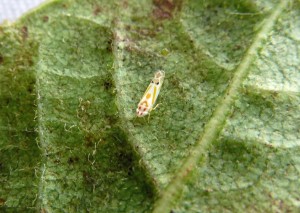3 July 2013 | Comments
St Helena is a small Island, eleven miles by seven in the middle of the South Atlantic Ocean. Although small it is still possible to lose things. Just occasionally, however, they turn up again. The 3mm long leaf hopper ‘Chlorita’ edithae was described from eight specimens collected by Vernon Wollaston during his visit to the island in 1875 and it hasn’t been seen since – until now.

On Bank Holiday 1 April 2013, while exploring tiny fragments of remaining natural vegetation above Wranghams on the high central ridge of the Island, Lourens Malan [Terrestrial Conservation Officer in the Environment Management Division (EMD) of the St Helena Government] noticed a few brightly-coloured leaf hoppers. Quickly grabbing his camera he managed to get several photographs of them. He later showed these to David Pryce (Invertebrate Conservation Co-ordinator at the St Helena National Trust) who nearly fell off his chair – it hadn’t been seen for 137 years.
This major discovery is all the more important as the hopper was found on the endangered endemic Whitewood Tree (Petrobium arboreum) of which there were only 80 surviving in 1995. Active conservation work on the Island has helped safeguard this species for the immediate future.
Most of the new stock has been grown from seedlings collected from the wild and grown on in more accessible areas where they could be tended for and monitored. As the plants collected were small it is less likely that they will have much of their associated fauna on them. Many of these insects have very poor dispersal abilities, further restricting their ability to form new colonies. Discoveries like this mean that steps can be taken to conserve these species as well as their plant hosts.
The isolated island of three Whitewood Trees where the hopper was found is in a sea of invasive New Zealand Flax (Phormium tenax). This shows how rare invertebrates can persist for long periods in very low populations. It is hoped that future work by the National Trust and the Environment Management Division will identify more of these isolated pockets. Their health will be assessed by looking at the diversity of their invertebrate populations and hopefully more discoveries (and rediscoveries) will be made.
Tara Pelembe, Head of the Environment Management Division said:
“We are very excited about this find. Our rarest plants and animals exist in tiny pockets of native habitats. These unique habitats need to be safeguarded. EMD is working with a range of partners and stakeholders to ‘effectively manage the Island’s environment’ – which is a national goal. We are very pleased to be working in partnership with the National Trust and Buglife on a much-needed Darwin invertebrate project which will help us to better understand the invertebrate species and habitats that exist on this unique Island.”
Notes to Editors:
For more information or an interview contact Vicky Kindemba: vicky.kindemba@buglife.org.uk or telephone (+ 44) 07880 316032
Buglife The Invertebrate Conservation Trust is the only charity in Europe devoted to the conservation of all invertebrates, and is actively working to save Britain’s rarest bugs, bees, butterflies, ants, worms, beetles and many more fascinating invertebrates. Further information is available on Buglife’s website at www.buglife.org.uk. Follow us on Twitter @buzz_dont_tweet and ‘Like us’ on Facebook: Buglife – The Invertebrate Conservation Trust
Darwin Initiative
The Darwin Initiative is funded by the UK Department of Environment, Food and Rural Affairs (Defra). The Initiative assists countries that are rich in biodiversity but poor in financial resources to meet their objectives under one or more of the three major biodiversity Conventions – the Convention on Biological Diversity (CBD); the Convention on International Trade in Endangered Species of Wild Flora and Fauna (CITES); and the Convention on the Conservation of Migratory Species of Wild Anima
ls (CMS) – through the funding of collaborative projects which draw on UK biodiversity expertise. The Darwin Initiative has invested £88,439,752 in 781 projects in 155 countries since 1992.
For media enquiries about the Darwin Initiative, please contact Laura Hunter on 0207 238 5334 or email laura.hunter@defra.gsi.gov.uk
St Helena Government
The St Helena Government’s Environmental Management Division was established in March 2013. Its mission is to ‘be the focus of environmental management for the St Helena Government through the creation and implementation of policy and legislation, and the provision of advice underpinned by a clear, transparent evidence-base – supported by systematic monitoring, evaluation, enforcement and a comprehensive communications strategy’.
For media enquiries about SHG’s Environmental Management Division, please contact Tara Pelembe, Head of Division at: tara-pelembe@enrd.gov.sh or on + (290) 2270.
St Helena National Trust
The St Helena National Trust is responsible for the protection, enhancement and promotion of St Helena’s unique environmental and cultural heritage. The Trust’s activities include restoration, conservation and education.
For media enquiries about the St Helena National Trust, please call (+290) 2190 or contact director@shnt.org.uk. Information about the Trust and its work can be found at www.nationaltrust.org.sh
Centre for Ecology and Hydrology
The Centre for Ecology & Hydrology is the UK’s Centre of Excellence for integrated research in terrestrial and freshwater ecosystems and their interaction with the atmosphere.
For media enquiries about Centre for Ecology and Hydrology, please contact Dr Barnaby Smith, Media Relations Manager, on tel.(UK): 01491 692439, mobile 07920 295384 or email bpgs@ceh.ac.uk
SHG
2 July 2013
Comments